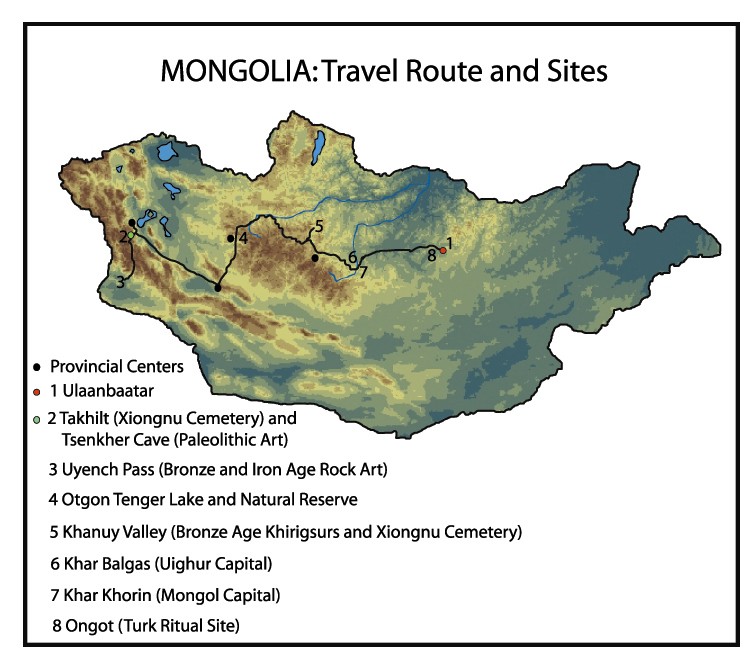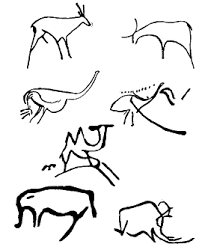Reproduction of cave painting, perhaps earliest depiction of Bactrian camel.
Paleolithic period, ca. 4000-15000 BCE.
 The Hoid Tsenheriin agui (other names: Northern Blue Mount's cave and Tsenheriin Agui) is a cave in Mongolia famous for its Paleolithic cave paintings featuring drawings and polychrome rock paintings of wild mammals and human hands. The Cave is located about 30 km from center of Mankhan sum (sub-province), about 80 km from center of Khovd aimag (province), Mongolia. This site was added to the UNESCO World Heritage Tentative List on August 1, 1996 in the Cultural category. The cave at Khoid Tsenkher, contains many figures and most of the major images have been painted onto the walls using mineral pigments (red and yellow ochre, hematite, manganese oxide and charcoal), although some designs have also been incised into the stone. The most famous section of the cave is Second hall where mammoths, ostriches, kannada antelopes are depicted. Additionally, the animals appear to be in motion. Scientists believe age of drawings of the Cave is approximately 40000 years old.
The Hoid Tsenheriin agui (other names: Northern Blue Mount's cave and Tsenheriin Agui) is a cave in Mongolia famous for its Paleolithic cave paintings featuring drawings and polychrome rock paintings of wild mammals and human hands. The Cave is located about 30 km from center of Mankhan sum (sub-province), about 80 km from center of Khovd aimag (province), Mongolia. This site was added to the UNESCO World Heritage Tentative List on August 1, 1996 in the Cultural category. The cave at Khoid Tsenkher, contains many figures and most of the major images have been painted onto the walls using mineral pigments (red and yellow ochre, hematite, manganese oxide and charcoal), although some designs have also been incised into the stone. The most famous section of the cave is Second hall where mammoths, ostriches, kannada antelopes are depicted. Additionally, the animals appear to be in motion. Scientists believe age of drawings of the Cave is approximately 40000 years old.

This is one of the largest caves in Mongolia, with a main chamber at least eighty-five feet high. A rock fall in 1995 blocked off one long extension in the cave, but several smaller galleries leading off from the main chamber still remain. It was reportedly inhabited by Stone Age people during the Upper Paleolithic, 10,000 to 40,000 years old. The cave is famous for its rock paintings, which have been dated to 17,000–22,000 years ago. Done with light pink and red-brown ochre pigments, the paintings depict Paleolithic fauna such as mammoths and ostriches which are no longer found in the area, as well as camels, ibex, deer, and other more familiar animals. Unfortunately many of the drawings have now been defaced or covered with dust and are no longer visible.
Cave of Khoid tsenkher is registered In the UNESCO "World Cultural Heritage List in 1996. And it was protected area of Mongolia in 1974.
 The paintings have been discovered in 1972 and include some amazing drawings of animals that no longer are found in Mongolia such as mammoths, elephants and ostriches. The cave is located in Monkh Khairkhan Uul that is a second highest mountain in whole Mongolia. The cave is not that easy to navigate and has numerous tunnels and passages and is 656 feet long; the biggest cavern being 50 feet high. This is the only cave in the whole Asia that has cave paintings from the Paleolithic period. Unfortunately some paintings have been covered by graffiti done by vandals.
The paintings have been discovered in 1972 and include some amazing drawings of animals that no longer are found in Mongolia such as mammoths, elephants and ostriches. The cave is located in Monkh Khairkhan Uul that is a second highest mountain in whole Mongolia. The cave is not that easy to navigate and has numerous tunnels and passages and is 656 feet long; the biggest cavern being 50 feet high. This is the only cave in the whole Asia that has cave paintings from the Paleolithic period. Unfortunately some paintings have been covered by graffiti done by vandals.
 |
| Small entrance |
 |
| Small entrance |
 |
| Khoid Tsenkher river valley |
 |
| Rock |
|
 |
| Main Entrance |
 |
| Camp sites |
 |
| Mouth of Cave |
 |
| Outside |
 |
| Cave painting - Camel bird |
 |
| Antilope |
 |
| Bactrian Wild Camel |
 |
| Mouth of Cave |
 |
| Inside |
 |
| Khoid Tsenkher river valley |
 |
| Rock Paintings around the Cave |
 The Hoid Tsenheriin agui (other names: Northern Blue Mount's cave and Tsenheriin Agui) is a cave in Mongolia famous for its Paleolithic cave paintings featuring drawings and polychrome rock paintings of wild mammals and human hands. The Cave is located about 30 km from center of Mankhan sum (sub-province), about 80 km from center of Khovd aimag (province), Mongolia. This site was added to the UNESCO World Heritage Tentative List on August 1, 1996 in the Cultural category. The cave at Khoid Tsenkher, contains many figures and most of the major images have been painted onto the walls using mineral pigments (red and yellow ochre, hematite, manganese oxide and charcoal), although some designs have also been incised into the stone. The most famous section of the cave is Second hall where mammoths, ostriches, kannada antelopes are depicted. Additionally, the animals appear to be in motion. Scientists believe age of drawings of the Cave is approximately 40000 years old.
The Hoid Tsenheriin agui (other names: Northern Blue Mount's cave and Tsenheriin Agui) is a cave in Mongolia famous for its Paleolithic cave paintings featuring drawings and polychrome rock paintings of wild mammals and human hands. The Cave is located about 30 km from center of Mankhan sum (sub-province), about 80 km from center of Khovd aimag (province), Mongolia. This site was added to the UNESCO World Heritage Tentative List on August 1, 1996 in the Cultural category. The cave at Khoid Tsenkher, contains many figures and most of the major images have been painted onto the walls using mineral pigments (red and yellow ochre, hematite, manganese oxide and charcoal), although some designs have also been incised into the stone. The most famous section of the cave is Second hall where mammoths, ostriches, kannada antelopes are depicted. Additionally, the animals appear to be in motion. Scientists believe age of drawings of the Cave is approximately 40000 years old. 



















No comments:
Post a Comment